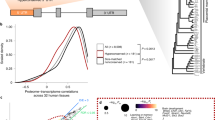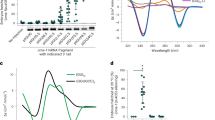Abstract
Regulation of messenger RNA is crucial in many contexts, including development, memory and cell growth. The 3′ untranslated region is a rich repository of regulatory elements that bind proteins and microRNAs. Here we focus on PUF proteins, an important family of mRNA regulatory proteins crucial in stem-cell proliferation, pattern formation and synaptic plasticity. We show that two Caenorhabditis elegans PUF proteins, FBF and PUF-8, differ in RNA-binding specificity. FBF requires the presence of a single 'extra' nucleotide in the middle of an eight-nucleotide site, whereas PUF-8 requires its absence. A discrete protein segment is responsible for the difference. We propose that a structural distortion in the central region of FBF imposes the requirement for the additional nucleotide and that this mode of PUF specificity may be common. We suggest that new specificities can be designed and selected using the PUF scaffold.
This is a preview of subscription content, access via your institution
Access options
Subscribe to this journal
Receive 12 print issues and online access
$189.00 per year
only $15.75 per issue
Buy this article
- Purchase on Springer Link
- Instant access to full article PDF
Prices may be subject to local taxes which are calculated during checkout







Similar content being viewed by others
References
Sonenberg, N., Hershey, J.W.B. & Mathews, M. (eds.) Translational Control (Cold Spring Harbor Laboratory Press, Cold Spring Harbor, New York, USA, 1996).
Kuersten, S. & Goodwin, E.B. The power of the 3′ UTR: translational control and development. Nat. Rev. Genet. 4, 626–637 (2003).
Sachs, A.B., Sarnow, P. & Hentze, M.W. Starting at the beginning, middle, and end: translation initiation in eukaryotes. Cell 89, 831–838 (1997).
van Hoof, A. & Parker, R. Messenger RNA degradation: beginning at the end. Curr. Biol. 12, R285–R287 (2002).
Lim, L.P. et al. Microarray analysis shows that some microRNAs downregulate large numbers of target mRNAs. Nature 433, 769–773 (2005).
Grabowski, P.J. & Black, D.L. Alternative RNA splicing in the nervous system. Prog. Neurobiol. 65, 289–308 (2001).
Wickens, M., Kimble, J. & Strickland, S. Translational control of developmental decisions. Translational Control (eds. Sonenberg, N., Hershey, J.W.B. & Mathews, M.) 411–450 (Cold Spring Harbor Laboratory Press, Cold Spring Harbor, New York, USA, 1996).
Wickens, M., Bernstein, D.S., Kimble, J. & Parker, R.A. PUF family portrait: 3′UTR regulation as a way of life. Trends Genet. 18, 150–157 (2002).
Edwards, T.A., Pyle, S.E., Wharton, R.P. & Aggarwal, A.K. Structure of Pumilio reveals similarity between RNA and peptide binding motifs. Cell 105, 281–289 (2001).
Wang, X., Zamore, P.D. & Hall, T.M. Crystal structure of a Pumilio homology domain. Mol. Cell 7, 855–865 (2001).
Wang, X., McLachlan, J., Zamore, P.D. & Hall, T.M. Modular recognition of RNA by a human pumilio-homology domain. Cell 110, 501–512 (2002).
Gerber, A.P., Herschlag, D. & Brown, P.O. Extensive association of functionally and cytotopically related mRNAs with Puf family RNA-binding proteins in yeast. PLoS Biol. 2, E79 (2004).
Bernstein, D., Hook, B., Hajarnavis, A., Opperman, L. & Wickens, M. Binding specificity and mRNA targets of a C. elegans PUF protein, FBF-1. RNA 11, 447–458 (2005).
Zhang, B. et al. A conserved RNA-binding protein that regulates sexual fates in the C. elegans hermaphrodite germ line. Nature 390, 477–484 (1997).
Crittenden, S.L. et al. A conserved RNA-binding protein controls germline stem cells in Caenorhabditis elegans. Nature 417, 660–663 (2002).
Lamont, L.B., Crittenden, S.L., Bernstein, D., Wickens, M. & Kimble, J. FBF-1 and FBF-2 regulate the size of the mitotic region in the C. elegans germline. Dev. Cell 7, 697–707 (2004).
Thompson, B.E. et al. Dose-dependent control of proliferation and sperm specification by FOG-1/CPEB. Development 132, 3471–3481 (2005).
Bernstein, D.S., Buter, N., Stumpf, C. & Wickens, M. Analyzing mRNA-protein complexes using a yeast three-hybrid system. Methods 26, 123–141 (2002).
Hook, B., Bernstein, D., Zhang, B. & Wickens, M. RNA-protein interactions in the yeast three-hybrid system: affinity, sensitivity, and enhanced library screening. RNA 11, 227–233 (2005).
Groves, M.R. & Barford, D. Topological characteristics of helical repeat proteins. Curr. Opin. Struct. Biol. 9, 383–389 (1999).
Huber, A.H., Nelson, W.J. & Weis, W.I. Three-dimensional structure of the armadillo repeat region of beta-catenin. Cell 90, 871–882 (1997).
Groves, M.R., Hanlon, N., Turowski, P., Hemmings, B.A. & Barford, D. The structure of the protein phosphatase 2A PR65/A subunit reveals the conformation of its 15 tandemly repeated HEAT motifs. Cell 96, 99–110 (1999).
Huxford, T., Huang, D.B., Malek, S. & Ghosh, G. The crystal structure of the IkappaBalpha/NF-kappaB complex reveals mechanisms of NF-kappaB inactivation. Cell 95, 759–770 (1998).
Jacobs, M.D. & Harrison, S.C. Structure of an IkappaBalpha/NF-kappaB complex. Cell 95, 749–758 (1998).
Graham, T.A., Weaver, C., Mao, F., Kimelman, D. & Xu, W. Crystal structure of a beta-catenin/Tcf complex. Cell 103, 885–896 (2000).
Kraemer, B. et al. NANOS-3 and FBF proteins physically interact to control the sperm-oocyte switch in Caenorhabditis elegans. Curr. Biol. 9, 1009–1018 (1999).
Luitjens, C., Gallegos, M., Kraemer, B., Kimble, J. & Wickens, M. CPEB proteins control two key steps in spermatogenesis in C. elegans. Genes Dev. 14, 2596–2609 (2000).
Eckmann, C.R., Kraemer, B., Wickens, M. & Kimble, J. GLD-3, a bicaudal-C homolog that inhibits FBF to control germline sex determination in C. elegans. Dev. Cell 3, 697–710 (2002).
Sonoda, J. & Wharton, R.P. Recruitment of Nanos to hunchback mRNA by Pumilio. Genes Dev. 13, 2704–2712 (1999).
Chattopadhyay, S., Garcia-Mena, J., DeVito, J., Wolska, K. & Das, A. Bipartite function of a small RNA hairpin in transcription antitermination in bacteriophage lambda. Proc. Natl. Acad. Sci. USA 92, 4061–4065 (1995).
Mogridge, J., Mah, T.F. & Greenblatt, J. A protein-RNA interaction network facilitates the template-independent cooperative assembly on RNA polymerase of a stable antitermination complex containing the lambda N protein. Genes Dev. 9, 2831–2845 (1995).
Legault, P., Li, J., Mogridge, J., Kay, L.E. & Greenblatt, J. NMR structure of the bacteriophage lambda N peptide/boxB RNA complex: recognition of a GNRA fold by an arginine-rich motif. Cell 93, 289–299 (1998).
Koudelka, G.B., Harrison, S.C. & Ptashne, M. Effect of non-contacted bases on the affinity of 434 operator for 434 repressor and Cro. Nature 326, 886–888 (1987).
Koudelka, G.B., Harbury, P., Harrison, S.C. & Ptashne, M. DNA twisting and the affinity of bacteriophage 434 operator for bacteriophage 434 repressor. Proc. Natl. Acad. Sci. USA 85, 4633–4637 (1988).
Olivas, W. & Parker, R. The Puf3 protein is a transcript-specific regulator of mRNA degradation in yeast. EMBO J. 19, 6602–6611 (2000).
Tadauchi, T., Matsumoto, K., Herskowitz, I. & Irie, K. Post-transcriptional regulation through the HO 3′-UTR by Mpt5, a yeast homolog of Pumilio and FBF. EMBO J. 20, 552–561 (2001).
Zamore, P.D., Williamson, J.R. & Lehmann, R. The Pumilio protein binds RNA through a conserved domain that defines a new class of RNA-binding proteins. RNA 3, 1421–1433 (1997).
Wharton, R.P. & Struhl, G. RNA regulatory elements mediate control of Drosophila body pattern by the posterior morphogen nanos. Cell 67, 955–967 (1991).
Sonoda, J. & Wharton, R.P. Drosophila Brain Tumor is a translational repressor. Genes Dev. 15, 762–773 (2001).
Acknowledgements
We thank members of the Kimble and Wickens laboratories for their suggestions, advice and comments on the manuscript, and we appreciate the suggestions of J. Kimble and S. Butcher. Figures were prepared by the University of Wisconsin Biochemistry Media Center. This work was supported by US National Institutes of Health grants to M.W. L.O. was supported by a US National Institutes of Health Molecular Biology Training Grant.
Author information
Authors and Affiliations
Corresponding author
Ethics declarations
Competing interests
The authors declare no competing financial interests.
Supplementary information
Supplementary Fig. 1
Alignment of RNA binding region of PUF proteins. (PDF 120 kb)
Supplementary Fig. 2
GST–FBF-2 and GST–Puf-8 proteins. (PDF 39 kb)
Supplementary Fig. 3
Junction sequences in FBF-1–PUF-8 chimeras. (PDF 43 kb)
Rights and permissions
About this article
Cite this article
Opperman, L., Hook, B., DeFino, M. et al. A single spacer nucleotide determines the specificities of two mRNA regulatory proteins. Nat Struct Mol Biol 12, 945–951 (2005). https://doi.org/10.1038/nsmb1010
Received:
Accepted:
Published:
Issue Date:
DOI: https://doi.org/10.1038/nsmb1010
This article is cited by
-
Expanding the binding specificity for RNA recognition by a PUF domain
Nature Communications (2021)
-
MINA-1 and WAGO-4 are part of regulatory network coordinating germ cell death and RNAi in C. elegans
Cell Death & Differentiation (2019)
-
Global pairwise RNA interaction landscapes reveal core features of protein recognition
Nature Communications (2018)
-
Modular assembly of designer PUF proteins for specific post-transcriptional regulation of endogenous RNA
Journal of Biological Engineering (2014)
-
A protein-RNA specificity code enables targeted activation of an endogenous human transcript
Nature Structural & Molecular Biology (2014)



